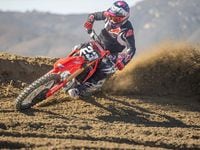When you put together a test on this scale, you are often looking for a specific location. It must not only have the capacity to accommodate the number of guests expected to attend but also be somewhere we can ride bikes for 24 hours without annoying the neighbors. Since this year's comparison would center on 250cc four-strokes, big sand hills, not being their forte, were out; so we searched for a new spot for our test. A couple of other elements factored into our decision to relocate the test from our previous location at Glen Helen Raceway Park in San Bernardino, California. The most visually obvious was the charred earth surrounding Glen Helen, as the famous track's outlying areas were completely scorched in the fires that burned more than 500,000 acres in Southern California in October 2003. We needed a place where the fickleness of Mother Nature wouldn't be a burden. Enter the I-5MX track at the Hungry Valley State Vehicular Recreation Area in Gorman.There, even if Mother Nature didn't help us, and she wasn't cooperating this past winter, the riding conditions wouldn't go south so quickly. Against a sure bet of deep silt and dust, the blue groove trails and sand-wash whoops did not look too bad. Add in the ample parking and recently revised and groomed track at I-5MX, and our choice was made. As it turned out, the biggest issue was the cold. But the track had a roomy, solid structure with plenty of heaters inside to defrost ourselves all night. The folks from anywhere else in the country thought we were silly complaining about the cold--the 30-something temperature was a welcome respite from the single and negative digits back home. In the end, Mother Nature begrudgingly gave in and threw some sprinkles our way during the night portion, and those who stuck around for day two got to enjoy awesome trail conditions.Timing is another critical element. We aimed to place the date between the local supercross rounds, so more of our guests could attend. This would make it early enough so that East Coast racers and teams could get the bikes we would be testing here and back home before the off-road race year began. The supercross schedule and this year's month-early GNCC season start meant we would hold our test in mid-January, which we had hoped would translate into more moisture on the trails and maybe even some good mud for our non-SoCal guests.As a public riding area, Hungry Valley added some new constraints to our test that we've never before had: All of our bikes had to be less than 96 decibels and equipped with spark arrestors--as is the case for anyone who desires to ride off-road on public land in California. We were also limited to the existing trail system when laying out our test loop. Not to worry: We were able to tie together an 18.5-mile course that even had an alternate tight, weaving section to give our testers an opportunity to witness the tight-terrain personalities of the 11 bikes in this year's two tests.The theme of the 2004 24-Hour was decided when Honda finally unveiled the latest in a long line of off-road thumpers, the CRF250X. We wanted to see how it stacked up against the incumbents in the 250 four-stroke enduro class, the KTM 250 E/XC RFS and Yamaha WR250F. Honda thumpers have long been a part of the 24-Hour. In fact, Dirt Rider's very first 24-Hour was a long-term test of Honda's XR350R. A second part of this year's test would be of a gathering of racer replicas (see accompanying story).The Stock Bike Test: CRF250X vs. 250 E/XC RFS vs. WR250FSo how are these baby thumpers, and which one should you buy? Oh, yes, the $64,000 question. The answer is it depends--on where you ride, how aggressive you are, your size, your skill level and, mostly, which dealer can give you the best deal and support. All three are that close. Picking a winner here is like choosing the class valedictorian from a room of straight-A students. The good news is there are no losers. All three sport the magic button, with a kickstarter as backup. We never had to flip out a kickstart lever.To put the bikes on equal footing since we were comparing apples, oranges and bananas, we decided to install the Pro Circuit 496 USFS-approved silencer on our three stock 250 four-strokes. Unfortunately, this plan backfired on us the moment the WR250F rolled up to the sound check. The little blue thumper spoke loud and clear--101 decibels with the PC unit on--and was sent back to the pits for the stock can and GYT-R insert. This dropped the noise level down to a reasonable 91 decibels, so we proceeded with our now-modified plan. We did get a chance to spend time on a stock CRF250X at night, and test consultant Dick Burleson rode the KTM prior to our changing the exhaust system. The Honda was probably helped more than the KTM with the aftermarket silencer.You know, someone in the marketing department at Honda must be a good card player. "Let the other guy show his hand first" comes to mind regarding this new production water-cooled, electric-start, 250cc four-stroke off-road machine from big red. Contrary to general expectations, the X version is not simply an "enduroized" clone of the motocross-only machine but is changed in every way, from chassis, suspension and power to exhaust system, plastic, off-road equipment and, of course, electric start.The biggest advantage Honda's CRF250X has over its classmates is weight, or the lack thereof, which translates into a very easy-to-flick-around bike. Changed your mind mid-turn? No problem: The Honda is so responsive that you can whip it around even in the middle of a course change. This trait earned it the most votes for best bike among the testers--who ranged in skill level from intermediate off-road riders to eight-time enduro champ Burleson. Although our main testing was done with the Pro Circuit USFS muffler, which gave a stronger overall powerband, a switch back to the stock muffler revealed surprisingly good power and response. It wasn't the horsepower winner, but since the gearbox ratios were perfectly matched, it was never at any noticeable disadvantage. Like the rest of the Honda clan, the 50-state-legal CRF250X rolls off the showroom floor with a Renthal bar and a gripper seat. If you are shorter than 5 feet 8 inches, the hardest part about purchasing the CRF250X is choosing which hand guards to add. Taller riders will be cramped; the X feels small and has a tight cockpit. Anyone near 6 feet tall will want a taller seat and the bar moved forward and up.When it comes to the best tall-person ergonomics, the green-sticker-legal/49-state closed-course KTM 250 E/XC RFS took the trophy. The new frame and suspension are a godsend to the orange bike. Now, if it had only shed a few more pounds during the transformation, it might have muscled the Honda out of the way. Unlike the Honda and Yamaha, the KTM does not like to be revved excessively; it performs best when you keep the engine right in the midrange. The bottom isn't as fluffy as that of the 250 of last year, but it's not as strong as the WR or CRF-X. Having said that, if you are a tall and aggressive rider, this bike will work well for you. The E/XC is stable at speed and works well in the tight stuff, but its weight holds it back and keeps it from attaining the woods virtuosity of the Honda. The KTM 250 also comes with top-notch parts such as the oversize Magura bar and oh-so-sweet hydraulic clutch.The biggest strength of the Yamaha WR250F is perhaps its engine and suspension. With a YZ-F throttle stop, GYT-R insert and gray wire disconnected, the red and blue machines were nearly identical. It was clear that Honda engineers had the Yamaha centered in their crosshair. However, the WR still felt as if it has the most bottom-end of the three yet can rev to the moon, building power all the way. The more wide open the trail, the better the Yamaha fares. It is noticeably more top-heavy than even the KTM, and pitching into a turn must be a deliberate act. Once committed, it steers accurately and predictably. It and the KTM are neck and neck in the whoops; both have the speed stability handled better than the skittish Honda (if you live out West and want the Honda, you should consider a steering stabilizer). The biggest hit against the wide-feeling WR is its weight. The Yamaha doesn't hide its pounds well, despite weighing about the same as the KTM. And compared with the outfitting the other two come in, the steel handlebar on the WR denies it that top-notch finish. The bar needs to be farther forward--the Yammer shares the cramped cockpit of the CRF but without the slim body underneath.Mind you, these differences only surface as a result of jumping off one bike and onto another back-to-back, so it might seem as though we're splitting hairs here. But that is the purpose of this test. Trying to choose a winner out of three closely matched contestants means we must examine their personality and look for annoying traits. Picking the right match for you will require some self-examination, and we're not talking about the kind you do in the shower.The Honda CRF250X takes the cake. Its svelte physique, easy-to-use power and well-finished package earned it the top spot. An important factor in ranking the bikes in our comparison is registration options. The Honda is the only bike of the three that is California green-sticker and EPA-legal, which means you can ride it in all 50 states. The KTM also has a green sticker, but it's a closed-course machine in the other 49 states. On the flip side is the Yamaha. It's a red-sticker/closed-course bike, which means places for riding it can be limited. It's a good race bike after all the necessary mods--something the other two don't require. The KTM 250 E/XC RFS also edged out its blue rival thanks to awesome ergonomics and a slimmer body, despite near-identical weights. Sometimes bigger is not better. That's the case for the stocky WR250F. Its girth caused dissatisfaction among the testers even with great stability and a strong motor.The Honda is still new and unproven, and its motocross sibling is already showing frequent top-end jobs are the way of the future for that high-performance thumper. These bikes are certainly not the XRs of yesteryear--you must do regular maintenance on them, or they'll present some not-so-cheap alternatives. Our CRF250X has about 36 hours on the stock piston (the press intro, 24-Hour and time on a dyno), and it is beginning to appear that a fresh piston and rings are in order. If you know how many hours of consistent riding you do on a trip, you can do the math. If you can handle top-end jobs on that kind of time schedule, then by all means add this little red thumper to your garage. The WR and KTM have lasted all year for us before, including being raced, without a whimper. These would be a better choice for those less maintenance savvy.It's a great time to be in the market for a small-bore thumper; barring the registration and noise limits, you still need to match yourself to the right bike. If we were spending money on one of these, it would be a toss-up among all three. Tall folks will have to put a taller bar and maybe a new clamp on both the Honda and the Yamaha to make them fit, something the KTM already does. If you ride where the trails are so tight that you never get out of the seat, the Honda and a trip to the aftermarket counter would be an appropriate choice. But if it's conditions such as out here in California, sticking to the heavyweights would be advised.Overall, the event was a success: no injuries, and it was a good learning experience for many folks, especially those who found out their bikes are nowhere near the 96-decibel limit. The regulation was perhaps stricter than most are used to and certainly more so than at any of the places many of our riders habituate, but the time for quiet bikes is now. A trend toward more-silent bikes will only help the sport. We'd like to extend thanks to Don Amador of the BlueRibbon Coalition and his group of volunteers, who braved the cold wind to handle the sound testing duties for us.
"We Gotta Light That?"We threw Alan Roach of Baja Designs a serious curveball this year. Equipping the 11 bikes with lighting to handle the night riding would prove to be the most-daunting of the tasks at hand and a formidable obstacle. Ironically, with this collection of competitors, the two-strokes--which are usually the source of angst--gave Roach and his team the least headaches. With so much new, never-before-seen machinery, the Baja Designs team was forced to develop some prototype stator coils. A lack of testing time and, on many bikes, available space may have led to three of our four bike failures during the 24-Hour. However, kudos to the Baja Designs team for picking up the ball— at the last minute in many cases— and showing up to do their usual light installation on our test bikes. Only the CRF250X and the Fred Andrews Replica RM250 didn't get the treatment. Honda borrowed a setup from its Baja race team, and the RM didn't have the capability to use a rewound stator, so it went into the dark sans lights.However, we did have helmet lights on hand to assist our riders in spotting obstacles. NiteRider and Cyclops sent support staff to help us get lit. With our testers hopping from bike to bike, the NiteRider system worked best for us since the lights are powered by batteries that can be carried in a fanny pack or jacket pocket. We did test a Cyclops system on a non-test bike since it required plugging into the bike's wiring harness; it worked excellently for a rider who wasn't switching bikes (see DR Tested for the full scoop). Next year, the Cyclops team said they would bring battery packs to better suit our unique requirements.Contact
Baja Designs: 800/422-5292; www.bajadesigns.com
Cyclops Motorsports: 800/624-0278; [www.cyclopsmotorsports.com
NiteRider: 858/268-9316; [www.niterider.com
Redline ReportThis is one of those instances in which the dynamometer matches the riding impressions. The KTM tops the gang, but the dyno confirms the E/XC goes no further after its midrange power apex. The Yamaha and Honda are practically equal in peak power. However, the WR gets the ponies out of the gate early, while the smooth curve replicates the electric power of F1-influenced CRF-X— a screamer that churns out the strongest numbers just before signing off.
Opinions****Dick Burleson 5'7"/150 lb/ancient AA rider
First place: Honda CRF250X. Right out of the starting gate this X-factor bike has them beat in one significant category: weight. The KTM and Yamaha feel about the same in mass when riding, being lifted onto a bike stand and steering or trying to lift the front end over whoops. The CRF250X feels much lighter in the front, has an overall lighter feel when riding and takes less grunt to get up on the bike stand. And that's good!The machine is much more compliant yet able to handle the biggest whoops, has much-more-friendly power but still is strong and is much more woods ready but still raceable for the masses. The handlebar, seat and footpeg relationship was good for my size, and the gas tank didn't intrude into my riding position as on the Yamaha. Overall, the CRF250X exceeded my expectations for engine performance, chassis comfort and suspension action. It was just plain more fun to ride.Second place: KTM 250 E/XC RFS. Last year, my off-road four-stroke of choice was a Thumper Racing 300cc version of the 250 E/XC RFS. The larger engine's extra boost balanced out the package and made for a fun, friendly and almost (but not quite) raceable machine. For '04, KTM updated the chassis, lowered the seat height, drastically improved the suspension on both ends and noticeably enhanced engine performance. Unfortunately, this model suffers compared with the Honda in both poundage and effort required when riding to stop or turn it. I was very comfortable in the cockpit of the KTM and liked the upgraded chassis and suspension. The test bike had a little glitch in the carburetion just off idle, but overall it produced enough power to be in the game. If KTM could put this bike on the Atkins diet, it still would be my favorite. But until that time, the CRF-X rules the roost.Third place: Yamaha WR250F. Coming in third sounds bad, but the reality is that the difference between the KTM and the Yamaha is pretty minimal. The WR makes more power and has a bigger midhit, but I didn't like the gearbox ratio gap between fourth and fifth. The chassis felt a little more solid than the Honda CRF-X's, and the suspension provided supple yet controlled performance and good traction when accelerating. The Yamaha shares the KTM's more-massive feel, but what made the slight difference between the KTM and Yamaha for me was the gas tank. It is wide; it intrudes on the space where my knees and legs want to be. The result is I tend to sit further rearward and thus work my forearms more to stay forward on the bike. My 30-inch inseam is no doubt a factor in this. But I have to ride with my legs, and neither the Honda's nor the KTM's gas tank intrudes on my riding space. It's a small difference, but since all three bikes are so good, each difference counts.Greg Herbold 6'/190 lb/Expert
KTM 250 E/XC RFS: The little KTM is a much-improved machine, with a motor that produces solid midrange punch. It pulls well off the bottom but prefers to be short-shifted and played with in the meat of its midrange. This means it requires quite a bit of shifting to keep it in the sweet spot. I was scolded for overrevving the orange bike--and maybe for good reason--but the Yamaha and Honda liked being revved. The layout is roomy and modern with a high bar, a flat seat and normal KTM ergonomics, which fit full-size guys just fine. The handling is best described as neutral. The rear suspension felt soft but controlled, and it never bottomed harshly; and the front fork worked fine.Honda CRF250X: The Honda is an attractive, modern-looking trailbike. The motor looks tiny, but don't let its size fool you. This little engine barks. The power is almost electric, with a good initial hit (it will even lug on the low-end like a much-bigger bike up slow hills), a controlled midrange and a pleasant boost of power on the top-end. And, yes, you can rev the CRF on short straights between corners without having to shift. The chassis is very forgiving in rocky sections and on trail stutter bumps, but some disturbing frame flex and "nonconfidence" was felt when pounding high-speed whoops and choppy, square-edged stuff. The bike feels really light under the rider and flicks back and forth through the woods with ease. Suspension, brakes and handling can best be described as excellent. My only problem is Honda designed the bike for a small person. It would fit my 5-foot-8-inch 120ish wife like a glove, but my lunker frame made the CRF-X look like an XR75.Yamaha WR250F: The Yamaha received some updates this year, all of them positive. The seat has a grippy cover, which is nice when you are on the gas. I like the WR motor the best. It pulls good enough off the bottom and can be flogged in the midrange, but the best part is the shrieking top-end. The engine runs very cleanly and consistently when the fuel mixture is properly tuned, and history tells me the 250 thumper is very dependable. The feel of the bike is more "full size" compared with the Honda. The WR does not feel as light as the CRF-X, but it does feel more solid and stable. The suspension is plush but firm and worked great. It may not be as good as the Honda's, but with some clicker tweaking it could be close. The WR seems the most happy on fast Western trails. Overall, this is a really good motorcycle.Robert Jordan 6'/180 lb/C rider
First place: Honda CRF250X. The Honda, Yamaha and KTM were very closely matched in power and handling. But the minute I threw a leg over the modified Honda, a smile was etched on my face. The front end tracked very well, though the steering is a little on the twitchy side. Regardless, the CRF-X stuck in the corners and was easily put full throttle through the whoops. Turning was light, and tight trails posed no issues. Rocky sections were a bit tense on the stock bike, but with the Pro Circuit exhaust I was able to keep the front up over obstacles. The Honda also has the best jumping behavior of all the bikes, with a very light and balanced overall feel. The Honda and Yamaha engines produced similar power, usable in most situations but requiring high rpm to retain the fun factor in fast whoops and steep hills.Second place: KTM 250 E/XC RFS. Of the stock bikes, the KTM suited my 6-foot frame perfectly. The front-heavy character of this 250 meant it tended to dive in the whoops, but the bike cornered like a champ. I was the most impressed by the engine. Its low-end torque was the best of all the bikes, except for the modified Honda. The KTM feels the most at home in very tight situations. The wide-ratio transmission did not suit the high-speed sand sections. In the tight section, I did come to appreciate the quick steering. It still has the hardest seat I've experienced. Long trail rides might be better met with a softer pad.Third place: Yamaha WR250F. With the GYT-R insert, the WR is the quietest bike of the three, but it feels plugged up. To make usable power, I was forced to rev the engine in all situations--perhaps Yamaha will one day figure out how to coax power from an engine without requiring excessive decibels. Suspension was fairly soft, and the ergonomics were a bit cramped. The handlebar position has little in the way of adjustability, and the tank seems big. Surprisingly, this didn't seem to affect the bike's ability to go fast. The Yamaha felt front-heavy but was amazingly stable at all speeds. Whoop sections that caused some anxiety on the Honda and KTM at speed were amazingly smooth and stress-free on the Yamaha. After a mile or so of riding, I didn't even notice the required adjustment in riding style and began to have some serious fun, especially in rocky and sandy areas.Bryan Nylander 6'/195 lb/C rider
KTM 250 E/XC RFS: I jumped from the Honda to the KTM and was--according to my cohorts--considerably faster. Perhaps it was agreeable ergonomics and an engine that demands the rider get aggressive. Of the three, the 250 E/XC was the best in the tall-person ergonomics. The new frame and engine tweaks vastly improved it over the '03 version. It can handle the Western whoops without the anxiety of the CRF250X, yet the orange bike was not a bull to turn in the tight stuff--it just required decisive moves. The engine is a midranger; as long as you keep it in the meat of the powerband, it rages quite nicely. Its biggest handicap is weight: It weighs nearly as much as its larger 525 sibling but with half the power.Honda CRF250X: I couldn't wait to get some time on the new CRF250X and scheduled myself for the first hour of testing. It comes with a grin factor--regardless of how fast you are, this bike is so much fun that you might have to get new cheek pads for your helmet. It is very rider-friendly: light, easy to start and, in the tight stuff, wonderfully agile. Beginners and advanced riders will be at home on the red machine. My biggest gripe was the small ergonomics--at 6 feet, my frame was folded up on the seat, and the bar felt as if it were just above my knees when standing. Compared with these stablemates, it was the hardest to go fast on for me. Think F1 car--that's how the engine wants to work. Granted, some of this was an attribute of the PC silencer we bolted on--I rode a stocker, and its bottom-end grunt was noticeably stronger and more WR-like. This bike will appeal to a wider range of riders than the other two, but I still gave it the number-two spot, mostly because the power was just so hard for me to use, and the cockpit made me want to just putt along the trail.Yamaha WR250F: The beefy power of the WR250F was its best trait. In fact, I was surprised at how much I liked the Yamaha. I have lots of time on a WR250F in hardpack and treacherous sand, but it pounded through the whoops with the stability of a Cadillac and for the Western conditions was the best bike. Get in the twisties, and you'll notice its girth and top-heavy feel. It'll carve graceful turns until the cows come home, but don't ask it to change directions as easily as you change your mind. Giving this bike third place was hard because it was so closely matched to the KTM, but it's just too wide. Were it ridden only out West, where I'm out of the saddle and the wide tank wouldn't bother me as much, the Yamaha would have placed second. The differences among these three are so slight that I'd be happy with any of them in my garage.Robert Rickgauer Jr. 5'11"/185 lb/B rider
Yamaha WR250F: The WR definitely feels easy to throw around, turns great and likes being in tight sections. However, it felt a little cramped compared with the Honda and KTM. And you needed to be on the gas to go anywhere. I thought it was underpowered on the hills unless I pushed the engine. The engine was just begging me to rip off the stock exhaust and bolt on a unit that would allow it to breathe. Basically, if you're aggressive, you will have fun on the WR250F. The suspension was matched to the bike; it was made for off-road. I rated this third.KTM 250 E/XC RFS: The 250 E/XC wasn't as powerful and as light as I thought it would be. I was expecting a strong 250 four-stroke that would pull off the bottom. But the bike hiccuped at the crack of the throttle. However, I found the power very comparable to the Yamaha. The ergonomics for my size and weight were friendlier. I felt the most comfortable on the KTM. It rode a bit straighter in the fast whoop sections, whereas the Yamaha sometimes dove into the whoops. For a 250, it does feel a bit on the heavy side. It tops the Yamaha in this class because of its ergonomics.Honda CRF250X: I must praise the suspension and handling of the new X. It was definitely the lightest of the three bikes. I had a great time flying around on the fast-paced trails and felt the fastest on the Honda. I didn't have to work too hard, and the bike would just go. The CRF-X had more roll-on torque than the other two bikes. It was fast, smooth and usable. The power pulled from the bottom to the top. Although the stock muffler produced powerful results, the Pro Circuit USFS muffler broadened the overall powerband. When jumping from bike to bike, I found the Honda surpassed the others in response, weight, handling and suspension. Although my impression of the CRF's ergonomics puts it between the KTM and WR, the Honda was just a little better in other areas. The CRF is one of those bikes that puts a smile on your face!
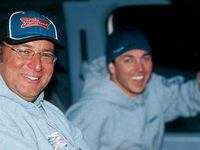
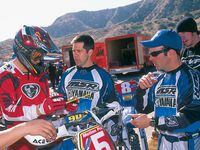
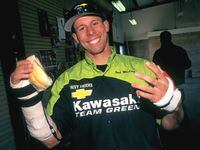
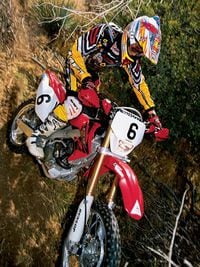
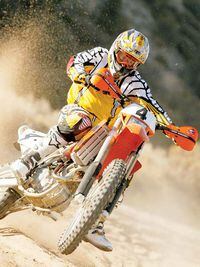
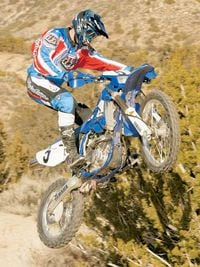
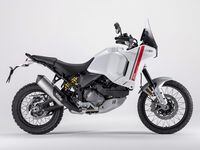

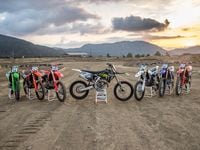




/cloudfront-us-east-1.images.arcpublishing.com/octane/3KQ6LKKNWJG5LBNYH6FKRV337A.jpg)









